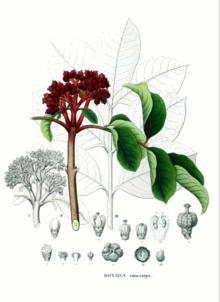Tetradium ruticarpum
This article needs additional citations for verification. (November 2014) |
| Tetradium ruticarpum | |
|---|---|

| |
| Scientific classification | |
| Kingdom: | Plantae |
| Clade: | Tracheophytes |
| Clade: | Angiosperms |
| Clade: | Eudicots |
| Clade: | Rosids |
| Order: | Sapindales |
| Family: | Rutaceae |
| Genus: | Tetradium |
| Species: | T. ruticarpum
|
| Binomial name | |
| Tetradium ruticarpum (A.Juss.) T.G.Hartley
| |
| Synonyms[1] | |
| |
| Regional names | ||||||
|---|---|---|---|---|---|---|
| Chinese name | ||||||
Hanyu Pinyin | wu zhu yu | |||||
| ||||||
| Japanese name | ||||||
| Kanji | 呉茱萸 | |||||
| Kana | ごしゅゆ | |||||
| ||||||
Tetradium ruticarpum is a tree that comes from China and Korea. It was previously classified in the genus
Production
Cultivation
Tetradium ruticarpum is grown mainly in China.
Harvesting
The fruit is picked. It may be consumed as food.
Traditional medicine
Traditional Chinese medicine
In traditional Chinese medicine the herb is described as a fruit.
Kampo
Tetradium ruticarpum is called 呉茱萸 (Goshuyu) in Japanese, used in Goshuyu-tou and Unkentou (ja:温経湯). These are Kampo (漢方) preparations of mixed herbs, the former named after this plant.[2] The mixture is noted for having a high concentration (132.6 to 706.3 mmol/100 g) of antioxidants, where the other constituents of the mixture rank lower.[3]
Contraindications
Allergic reactions have occasionally been reported in users of medicinal preparations of the plant.[citation needed]
Biochemical analysis
There has been relatively little scientific study of Tetradium ruticarpum except for antioxidant capacity of one of its mixtures.
Notable compounds in T. ruticarpum include:[4]
- COX-2 inhibitor
- 0-hydroxyrutaecarpine
- evodiamine, a possible thermogenic agent and stimulant, named after the former name of the genus
- dehydroevodiamine
- synephrine, an adrenergic receptor agonist
- 1-methyl-2-n-nonyl-4(1H)quinolone
- evocarpine
- dihydroevocarpine
In rats, the half-lives of most of these compounds was found to be relatively short, between 0.5 - 2 hours.[4]
Variants
There are a few variants:[5]
- var. officinalis
- var bodinieri (Dode) Huang
References
- ^ "Tetradium ruticarpum (A.Juss.) T.G.Hartley". World Checklist of Selected Plant Families. Royal Botanic Gardens, Kew. Retrieved 21 November 2014 – via The Plant List. Note that this website has been superseded by World Flora Online
- ^ "Kampo virtual class | Japanese Kampo Medicine|Kampo Igaku Center Keio University Medical School".
- PMID 20096093.
- ^ S2CID 31746179.
- ^ "Goshuyu".
